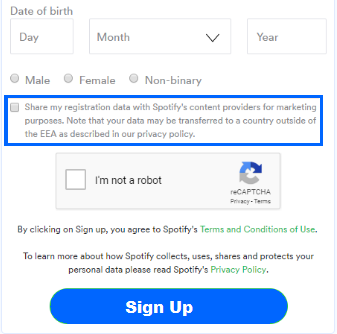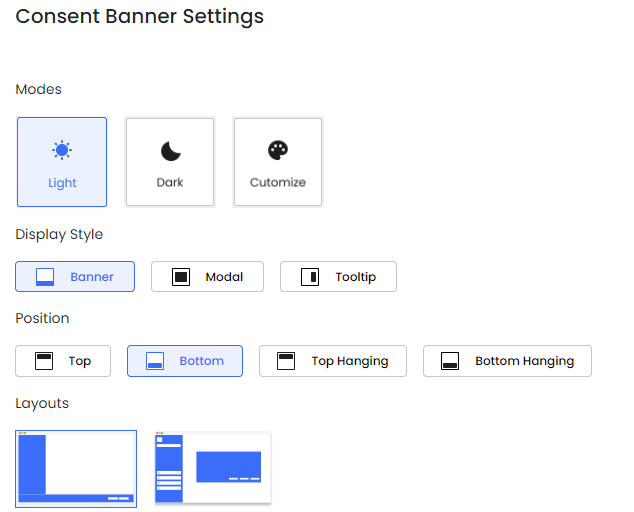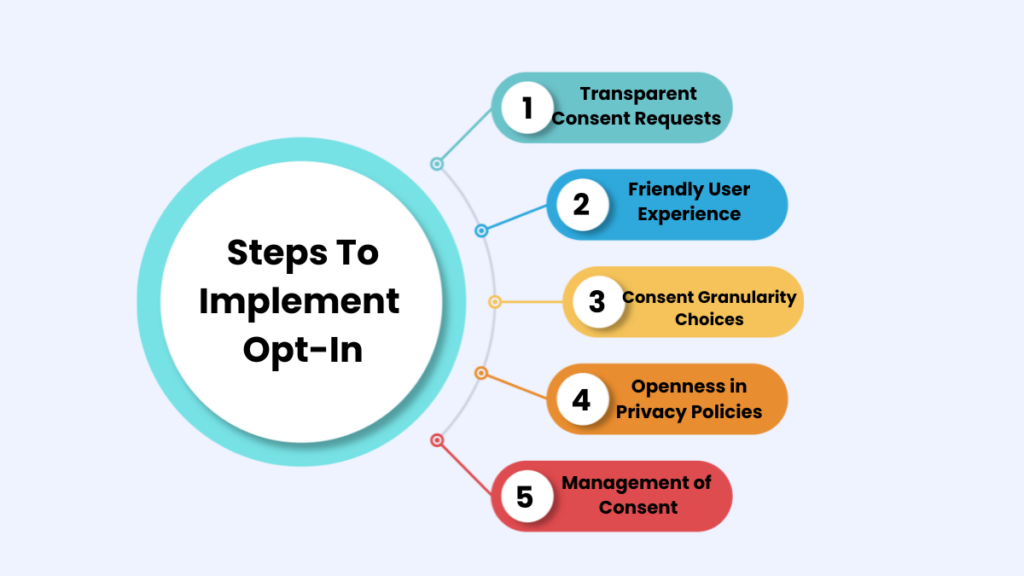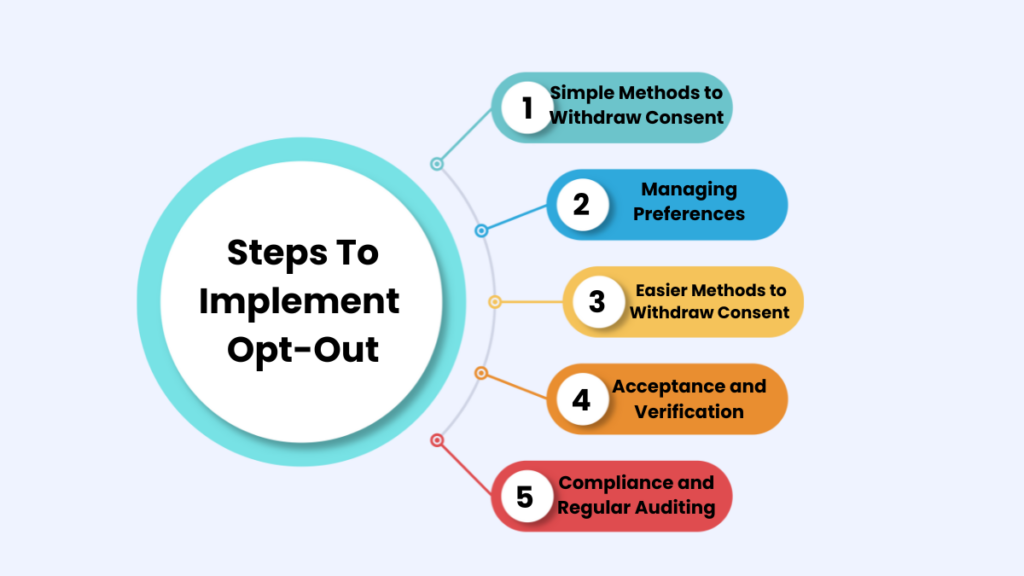In this rapidly growing world, every state has increased its urge for privacy protection. The phrases “opt-in” vs “opt-out” play crucial roles in digital marketing and data protection. Although they share a common theme—the need for users’ approval before proceeding—there are significant differences between the two notions.
The distinction between opt-in vs opt-out is very important for consumers and companies alike to grasp. This essay will help you understand What is opt-in and opt-out, ideas and their ramifications so that you can make better choices.
What is opt-in?
Opt-in is a consent method in which people voluntarily consent to an organisation’s collection and use of their personal information. It allows the user to participate in a service, receive messages, or gather data at their own discretion.
This could involve:
- Clicking a button labelled “Accept Cookies.”
- Completing a form specifying cookie preferences
This approach focuses on giving users control and being transparent, including clear terms of services. Users make an informed decision about whether to allow cookies and have their data collected. This is known as “opt-in” in the context of digital marketing and data protection. Users may indicate their interest in participating, sharing data, or receiving marketing emails by selecting the “opt-in” radio button.
Examples of Opt-In Mechanisms:
- Checkboxes on a signup form allowing users to choose which cookies they accept (e.g., analytics, marketing).
- Consent forms requiring users to explicitly agree to cookie usage, including Google Analytics, ensuring compliance with global privacy laws before accessing specific website features.
- Cookie banners with prominent “Accept” or “Manage Preferences” buttons.
What is opt-out?
By default, people are registered, or their personal data is gathered via an opt-out consent mechanism unless they take affirmative steps to refuse or unsubscribe. Unless the user explicitly opts out of a service, data collection, or communication, permission is presumed in an opt-out system.
Users are routinely included in mailing lists, advertising campaigns, or data-sharing agreements without their knowledge or consent until they actively choose to remove themselves. Emails, push notifications, and other forms of contact may be used to inform consumers of their options to opt out of future interactions.
Examples of Opt-Out Mechanisms:
- Pre-checked boxes that users can uncheck to opt out
- Unsubscribe links in emails or marketing communications

Is opt-in and opt-out a good approach?
What is the Difference Between Opt-In and Opt-Out
| Feature | Opt-In | Opt-Out |
| User Action | The user takes a clear action to give consent | The user does nothing initially but can opt-out later |
| Example Mechanisms | Checkbox requiring selection, “Accept Cookies” button | Pre-checked boxes (with a clear opt-out option), unsubscribe links |
| Data Privacy Focus | Prioritises user control and informed consent | Offers flexibility for initial access |
| Compliance Requirements | Explicit consent, informed consent | Right to opt-out, potentially for non-essential cookies |
| Best Practices | Layered opt-in, clear explanations of cookie types | Easy-to-find opt-out options, respecting unsubscribe requests |
| Alignment with Regulations | GDPR, LGPD | CCPA |
Try Seers for Free
At Seers, we simplify compliance with our intuitive GDPR and CCPA solutions. Streamline your data protection efforts and stay ahead of regulations with ease.

Try our cookie consent management solutions for FREE!
Sign Up For Free
Can we combine opt-in and opt-out effectively?
Absolutely, combining opt-in and opt-out approaches can be an effective way to manage cookie consent while balancing user control and website functionality.
Benefits of Combining Opt-In and Opt-Out:
- User Control: Gives users a clear option on how their data is collected.
- Flexibility: This lets users access the website right away and make choices about their data later.
- Compliance: Can help meet the requirements of various data privacy Laws
Effective Implementation:
- Tiered Opt-In: Ask for clear consent for essential cookies needed for basic website functions (like managing sessions) to ensure a smooth user experience.
- Opt-Out for Non-Essentials: To allow personalisation and data collection while respecting user choices, let users opt out of non-essential cookies, such as those for marketing or analytics.
- Clear Communication: Use a GDPR cookie consent popup that explains the purpose of different cookies and the choices available (opt-in for essential cookies, opt-out for non-essential ones).
How and When To Use Opt-In And Opt-Out?
How? Implementing the proper tactics and practises to assure compliance, respect user choices, and achieve the intended goals is essential for the successful usage of opt-in and opt-out. Here are some recommendations for making the most of opt-in and opt-out methods:
Use Opt-In When:
- You collect essential cookies for website functionality (e.g., shopping cart, login sessions).
- You handle sensitive data (e.g., health information, political views).
- You want to comply with regulations like GDPR and LGPD that emphasise user control.
Use Opt-Out When:
- You want to offer flexibility for initial website access without immediate cookie decisions.
- You collect less privacy-sensitive data, e.g., browsing preferences.
- You want to combine opt-out with a phased opt-in approach for specific features
Opt-in Implementation:

1. Transparent Consent Requests:
Give clear and comprehensive explanations of how your data is collected and used. Make the intent, reach, and consequences of opting in very clear. Communicate with your audience using simple, clear words.
2. Friendly User Experience:
Create interfaces that make it easy for people to give their permission. Make sure any checkboxes or permission forms you use are clearly labelled and simple to complete.
3. Consent Granularity Choices:
Give consumers the option to give permission to collect and use their data for particular reasons. This enables people to make educated decisions about how involved they want to be.
4. Openness in Privacy Policies:
Ensure users can readily find your privacy policy, terms and conditions, and cookie policy, providing detailed information about the data collection, storage, and usage processes. Connect the privacy statement to the permission form for full disclosure.
5. Management of Consent:
Create a reliable system for handling and documenting permissions granted by users. Keep a database recording each user’s consent time, date, and specifics. The consent management platforms are functioning for user’s permissions.
Opt-out Implementation:

1. Simple Methods to Withdraw Consent:
Make it easy for people to stop receiving information or unsubscribe if they no longer choose. Provide clear directions on how to unsubscribe from emails and other correspondence.
2. Managing Preferences:
Make it simple for consumers to choose and change their preferred contact methods. Give users some control panel or account options to modify things like how often they get updates and what kind of data they want to see.
3. Easier Methods to Withdraw Consent:
Make the procedure of declining to participate as easy and quick as feasible. Do not have people fill out lengthy forms or go through many processes to disable the feature.
4. Acceptance and Verification:
Notify users with confirmation messages after they have successfully unsubscribed. Users may rest easy knowing their feedback has been considered and acted upon.
5. Compliance and Regular Auditing:
Maintaining opt-out methods under data protection laws requires regular assessment and revision. Always keep up with the latest developments in opt-out legislation and regulations.
Opt-In and Opt-Out in Cookies: Compliance Requirements
Data privacy regulations have specific rules for opt-out and opt-in methods when using cookies. Here are the main compliance points for each:
Opt-In Compliance Requirements
Explicit Consent: Users must clearly agree to allow cookies. Pre-checked boxes or requiring users to opt-out do not count as explicit consent.
Informed Consent: Users should know which cookies are being used, why they are used, and the effects of their consent. The cookie banner should explain:
- Types of cookies. For Example, essential analytics, advertising
- Purpose of each cookie type
- How data from cookies will be used. For Example: website personalisation, advertising
- Users’ rights regarding their data. For Example, access, correction, deletion
Opt-Out Compliance Requirements
Consent Withdrawal: Users should be able to withdraw their consent to cookies at any time, even if they initially agreed.
Right to Opt-Out: Essential cookies for website functionality might be exempt from opt-in, but users should still be able to easily opt out of non-essential cookies. This can be done through a preference center or settings page on your website.
Legal Framework and Regulations: Navigating Opt-In and Opt-Out
Opt-in vs opt-out approaches offer flexibility, and data privacy regulations set the ground rules. Let’s delve into how these mechanisms work within the framework of key regulations:
1. Opt-Out under CCPA (California Consumer Privacy Act):
How Does Opt-Out Work in CCPA?
The California Consumer Privacy Act of 2018 allows users to opt-out of the “sale” of their personal information to third parties. They can request that companies not share their data for advertising or other commercial purposes. Businesses must provide a clear “Do Not Sell My Personal Information” link on their website.
What Does CCPA’s Opt-Out Mean for Businesses?
Businesses operating in California and collecting data from California residents must comply with the CCPA’s opt-out requirements. Failure to do so can result in hefty fines and reputational damage.
Violating the CCPA, even unintentionally, can result in fines of up to $2,500 per unintentional violation and $7,500 per intentional violation.
What Does CCPA Say About Child Privacy?
The CCPA offers specific protections for children under 13. Businesses must obtain verifiable parental consent before selling a child’s personal information
2. Opt-In under GDPR (General Data Protection Regulation):
How Does Opt-In Work in GDPR?
The GDPR rules say that websites must ask you clearly if they can use cookies on your device. They need your permission before they can store cookies. They have to give you an option to say “yes” by clicking on a button like “Accept Cookies.”
What Does GDPR’s Opt-In Mean for Businesses?
Businesses operating in the European Union must comply with GDPR’s opt-in requirements. Websites must ask for clear and specific permission before using cookies or collecting your data. Failure to do this will result in hefty fines and penalties.
In October 2020, H&M was fined €35.3 million by the Hamburg Data Protection Authority (HDPA) for illegally monitoring employees’ activities.
What Does GDPR Say About Child’s Privacy?
GDPR offers specific protections for children. Parental consent is generally required for data collection for children under 16, but the particular age can vary depending on the EU member state.
In September 2022, Meta was fined €405 million by Ireland’s Data Protection Commission for its handling of children’s data on Instagram.
3. Opt-In under LGPD (Lei Geral de Proteção de Dados – Brazilian General Data Protection Law):
How Does Opt-In Work in LGPD?
LGPD emphasises user control and informed consent. Businesses must obtain consent from users before processing their data, including cookies.
What Does LGPD’s Opt-In Mean for Businesses?
Businesses operating in Brazil must comply with LGPD’s opt-in requirements. This includes providing clear information about data collection purposes and obtaining user consent through explicit opt-in mechanisms.
What Does LGPD Say About Child’s Privacy?
LGPD requires specific parental or guardian consent for processing the personal data of children under 12 years old.
Industry-Specific Applications:
Opt-in and opt-out work can vary in different industries, like email marketing. We’ll explore how these mechanisms are explicitly applied to email marketing:
Opt-In for Email Marketing:
- Double Opt-In: After signing up for emails, you get a confirmation email with a link to click and verify your subscription.
- Clear Opt-In Forms: When you sign up, the form should clearly explain what you’re signing up for, such as promotional emails, and what information will be collected. Avoid automatically ticking boxes for extra subscriptions.
- Privacy Policy Link: The sign-up form should have a link to your website’s privacy policy for transparency.
Opt-Out Functionality in Email Marketing:
- Easy Unsubscribe Options: Every email must have a noticeable unsubscribe link, usually at the bottom.
- One-Click Unsubscribe: You should be able to unsubscribe with just one click without needing to log in or do anything else complicated.
- Respecting Unsubscribe Requests: Once someone unsubscribes, promptly take them off your email list as requested.
This is required under the CAN-SPAM Act and is enforced by the Federal Trade Commission (FTC) in the United States.
Benefits of using Opt-in and Opt-Out
| Feature | Opt-In | Opt-Out |
| User Control | High | Medium |
| Transparency | Encourages clear communication about data collection | It may require additional effort to explain opt-out options |
| Engagement | Users who opt-in are likely more engaged with your website or marketing | May have a larger pool of initial website visitors |
| Data Quality | Data collected through opt-in is likely more accurate and relevant | Data quality may be lower as some users may not actively opt-out |
| Legal Compliance | Aligns well with regulations like GDPR and LGPD | It may be sufficient for less privacy-sensitive data but may not meet all compliance requirements in some regions |
| Brand Reputation | Demonstrates respect for user privacy | It may be perceived as less user-friendly or transparent |
Drawbacks of using Opt-In and Opt-Out
| Feature | Opt-In | Opt-Out |
| User Engagement | It may lead to a smaller initial pool of users willing to engage with cookie consent | It May have a larger pool of unengaged users who haven’t opted out |
| Data Collection | It may result in less data collected, potentially impacting website personalisation or analytics | Data quality may be lower as some users may not actively opt-out, leading to irrelevant data |
| Conversion Rates | Complex opt-in processes can discourage users from converting (e.g., making purchases) | Users may feel frustrated if they accidentally opt out of essential cookies |
| Implementation Complexity | Requires more complex implementation with detailed consent screens and granular control options (depending on regulations) | It is more straightforward to implement initially, but managing opt-out preferences can become complex |
| Compliance | It may not meet all compliance requirements in some regions, especially those emphasising explicit user consent | It may not be sufficient for handling sensitive data, potentially leading to legal risks |
| Brand Perception | It may be perceived as overly cautious or hindering user experience | It may be perceived as less transparent or user-friendly if opt-out options are not clear |
Future of Opt-in and Opt-out Consent
The world of online privacy is always changing, and how we handle opt-in and opt-out consent is evolving with it . Here are some potential trends to consider:
Tougher Rules: Governments worldwide are getting stricter about how companies handle your data. They might require clearer permission for sensitive info or when data moves across borders. Laws Like GDPR.
More Openness: Companies might start being more upfront about how they use your data. This means clearer explanations and simpler forms for you to decide what you’re okay with.
New Tech Solutions: Technology, like AI, could make it easier for companies to get your permission in a way that suits you. They might offer more personalised choices based on what you like.
Knowing Your Rights: As people learn more about their data rights, they’ll likely want clearer and more meaningful ways to agree to data use. This could mean more options for what data you allow companies to use.
Global Rules: Right now, data rules can vary widely. There could be a push for more similar rules everywhere so they’re easier for companies to follow and for people to know what to expect.
Opting Out Easily: While it’s usually better for companies to ask you before using your data, sometimes you might want to say no later. Making it simple to change your mind could become really important.
Ethical Choices: There might be more talk about the right and wrong ways for companies to ask for your data. This could affect how they do it, even beyond what the law says.
Why should businesses use opt-in and opt-out?
- Maintain trust with clientele by providing opt-in and opt-out procedures
- Emphasise openness and respect individual choices
- Verify serious customer interest through opt-in processes
- Earn consumers’ trust and loyalty by respecting autonomy and privacy
- Stay compliant with data protection standards and other laws with opt-in systems
- Allow users to disconnect from unwanted services with opt-out systems
- Demonstrate respect for customers through opt-out options
- Enhance individual control over online experiences
- Benefit brands with favourable publicity
- Strengthen relationships through mutual trust and respect
Conclusion:
Opting in vs opting out procedures provide significantly different levels of control and privacy, despite both having their place in digital interactions. Opt-in puts control in users’ hands, increasing openness, trust, and adherence to privacy laws.
On the other hand, opting out might lead to less user agency, privacy worries, and even legal issues. Individuals and companies can better secure their personal information, build customer trust, and adhere to new regulations on data protection if they are aware of the differences between opt-in and opt-out
FAQ
What are opt-in and opt-out cookies?
Legal constraints and the website’s privacy policies may affect cookie opt-in and opt-out. To protect user privacy and maintain openness, websites should tell users about cookie use, their objectives, and how to manage cookie settings.
On which continents optin is used?
The major parts of the world are Europe, the United States, and the Asia-Pacific, including Canada, Australia, Japan, and South Korea.
What does opt out mean in company?
Individuals may “opt-out” of a company’s programs, services, or communications. It lets people opt out of default inclusion and particular services.
